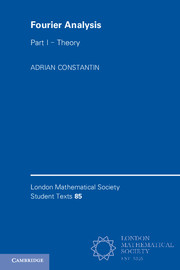Book contents
- Frontmatter
- Dedication
- Contents
- Preface
- 1 Introduction
- 2 The Lebesgue measure and integral
- 3 Elements of functional analysis
- 4 Convergence results for Fourier series
- 5 Fourier transforms
- 6 Multi-dimensional Fourier analysis
- 7 A glance at some advanced topics
- Afterword
- Appendix Historical notes
- References
- Index
Preface
Published online by Cambridge University Press: 05 May 2016
- Frontmatter
- Dedication
- Contents
- Preface
- 1 Introduction
- 2 The Lebesgue measure and integral
- 3 Elements of functional analysis
- 4 Convergence results for Fourier series
- 5 Fourier transforms
- 6 Multi-dimensional Fourier analysis
- 7 A glance at some advanced topics
- Afterword
- Appendix Historical notes
- References
- Index
Summary
Fourier analysis is a central area of modern mathematics, comprising deep results that rely on advanced principles, as well as numerous aspects that require manipulative ingenuity. The power of the theory is illustrated by its wide applicability. Ideas originating in Fourier analysis permeate many essential developments of modern mathematics, bridging analysis with algebra and providing effective tools for an astonishing variety of applications. We list here an alphabetical sample of subjects, illustrating either areas of mathematics with strong links to Fourier analysis or real world applications of Fourier analysis, that are covered briefly in this textbook: acoustics, complex analysis, functional analysis/operator theory, group theory/representation theory, heat flow, hydrodynamics, image processing, medical imaging, number theory, optics and astronomy, partial differential equations, probability and statistics, quantum mechanics, signal processing.
While formal approaches to Fourier analysis can be informative, to appreciate the subject fully and to strengthen the ability to use it in other contexts, one has to acquire a certain mathematical sophistication that draws on measure theory and functional analysis. Lebesgue's integral and the concepts of Hilbert and Banach spaces are intimately connected to Fourier analysis, providing not only an adequate setting but also being useful in obtaining fundamental results, often with surprisingly little effort. A detailed presentation of measure theory and functional analysis would be out of place in an introductory textbook, but ignoring these topics would amount to a lamentable attempt to run before we have learned to walk. For this reason we outline in Chapters 2 and 3 the principal facts about the Lebesgue integral and Hilbert/Banach spaces, as needed later, emphasising and illustrating the relevant conceptual ideas. This should provide some essential intuition that must, nevertheless, be adequately backed up by analytic rigour, so that we present at least sketchy proofs, avoiding only the proofs that demand an advanced degree of technical versatility. The reader may take on faith the results stated without proof, but detailed references for further study are provided. This material offers, to the interested reader, a basis for a solid grounding in these aspects and has been “class-tested” to groups of graduate students at Lund University and at the University of Vienna (during the academic years 2002–2004 and 2014–2015, respectively). However, the material in Chapters 2 and 3 is not an integral part of a standard course.
- Type
- Chapter
- Information
- Fourier Analysis , pp. xi - xivPublisher: Cambridge University PressPrint publication year: 2016



